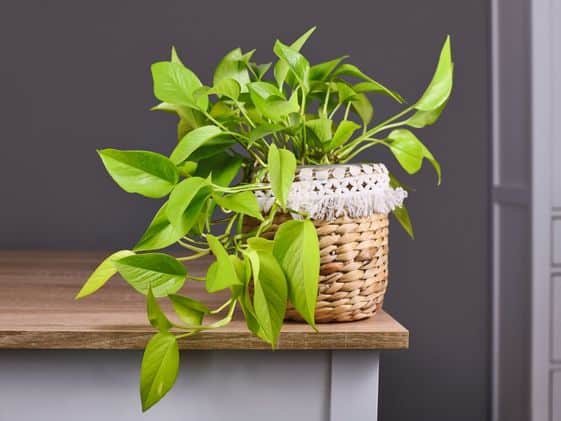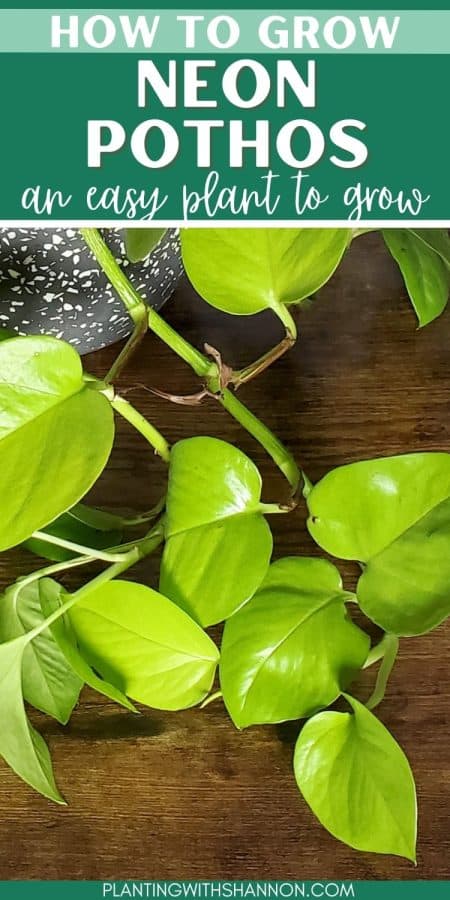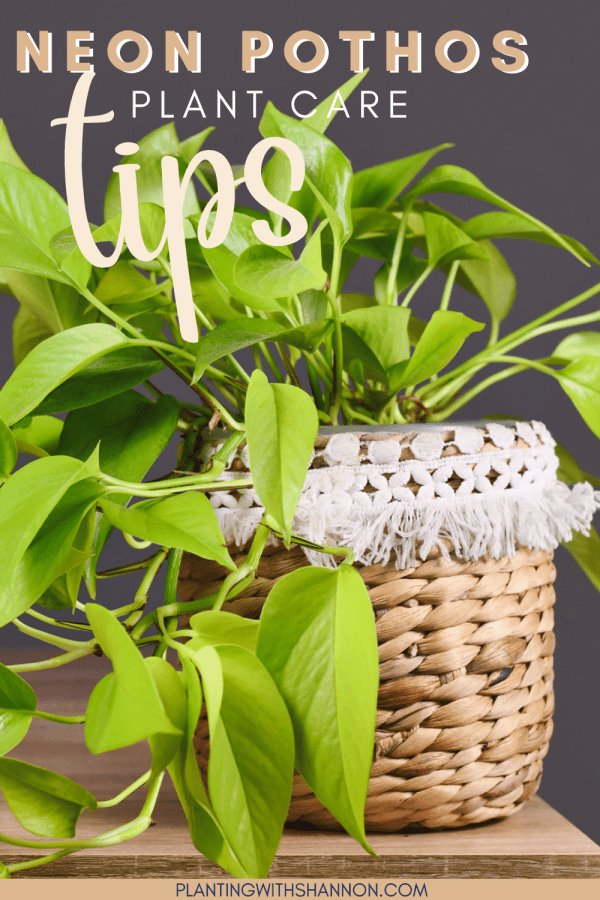Neon pothos plants have quickly become popular indoor plants.
These beautiful, easy-to-care-for plants are perfect for bringing a bit of green into your home if you know how to care for them properly.
That’s why we’ve put together this ultimate guide to caring for a neon pothos plant!
Keep reading to learn everything you need to know about these amazing plants.
This post may contain affiliate links. That means if you click on them and buy something, I may receive a small commission. Read my Disclaimer Policy to learn more. As an Amazon Associate, I earn from qualifying purchases.
What is a neon pothos?

The Neon Pothos, scientific name Epipremnum aureum ‘neon’, are tropical plants native to the Solomon Islands, but can also be found in any subtropical climate area.
It’s a vining plant with heart-shaped leaves and is named for its neon green leaves.
Neon pothos plants are beautiful, low-maintenance plants that are perfect for adding a bit of green to your home.
Is neon pothos rare?
No, neon pothos plants are not rare. But, depending on your area, neon pothos can be a little harder to find than some really common plants, like golden pothos.
Most garden centers, nurseries, and even big box stores have neon pothos for sale throughout the year. My husband bought me one at Walmart last summer. Since then they show up every few restocks.
They are relatively affordable and are a great option for anyone looking to add some color to their home.
Are neon pothos poisonous/toxic?
Yes, neon pothos is considered toxic to both people and animals if ingested.
All pothos contain a substance called calcium oxalates which can cause oral irritation, vomiting, and difficulty swallowing.
Neon pothos care

Neon pothos is easy to care for and only requires a few things to stay happy.
Here’s what you need to know about neon pothos care:
Lighting
Neon pothos plants love bright indirect light but can tolerate lower light conditions. They should be placed in an area that receives plenty of light but not in direct sunlight.
Too much direct sunlight can cause the leaves on your plant to burn and turn brown or yellow.
If you don’t have an area in your home that gets enough natural light, you may want to invest in some grow lights as an added measure.
Watering
Proper watering is one of the most important factors in keeping your pothos happy and healthy. Neon pothos like to have moist soil, but not soggy soil. They like their soil to dry out some between waterings.
You want to aim for watering when the top inch of the soil is dry. When you water, give it a good drink, allowing the water to run out the bottom of the pot.
Just make sure to pour off any excess water that runs out the drainage hole so the pothos isn’t sitting in water. Otherwise, it could develop root rot from too the soil staying too wet.
On average, I tend to water my pothos every week to two weeks depending on how fast the soil dries out. This varies depending on how warm and humid my house gets, which does vary some with the seasons.
Humidity
Neon pothos appreciates higher humidity, but they are very tolerant and can survive in lower humidity.
My house routinely gets down to 35% humidity in the winter and all of my pothos continue to grow nicely. The lack of natural light is more of an issue than the lack of humidity.
You can give your plants a boost in the humidity levels by grouping them together. This helps to trap the humidity that is naturally created by the plants.
Another option if your home is naturally low in humidity is to invest in a humidifier that you run near your plants. I don’t think this is necessary for neon pothos, and there are potential risks.
If you have too much humidity in your home, you can end up causing moisture build-up that can lead to mold issues, particularly in cool, low-air movement areas of your home.
Temperature
Neon pothos prefers warm temperatures between 65-75 degrees Fahrenheit. But, it can tolerate slightly cooler temperatures. My neon pothos is in a room that stays between 62 and 68 degrees Fahrenheit and is growing well.
While they can tolerate cool temperatures, they cannot tolerate cold temperatures and will die if allowed to freeze.
Soil
Neon pothos prefers well-draining potting soil. I prefer to use Miracle Grow potting soil and sometimes add some orchid bark.
You can add perlite as well, but I’m not a fan of how perlite can look like mealybugs. I’m a little paranoid after I found mealybugs on a couple of my plants.
But pothos isn’t very picky and if you want to use a commercial potting soil like Miracle Grow straight from the bag, that will be fine as well.
Fertilizing
Whether you need to fertilize your neon pothos or not depends on how recently you repotted it and what type of potting soil you used.
If you recently repotted your neon pothos and used a potting mix that includes fertilizer, like Miracle Grow, you don’t want to add additional fertilizer. Too much fertilizer isn’t good for any plant.
The potting mix you use should say how long the fertilizer in the bag is good for. Don’t add additional fertilizer until that time frame has passed.
Once you have passed the time on the potting soil bag, adding additional fertilizer can help keep your neon pothos healthy. This is because it adds back the nutrients that the plant has pulled out to continue growing.
Use a balanced liquid fertilizer for houseplants and follow the directions on the package for how much to use and how often.
Pruning Your Plant
Neon pothos is a fast-growing plant and can get rather leggy if not pruned regularly.
You will want to cut off the stems that have become too long and made your plant look lanky. Pruning also encourages the plant to bush out more, creating a fuller appearance.
When you prune, cut the stem a few inches below where you want it to stop. This will encourage new growth from the node just beneath the cut.
If your neon pothos is particularly overgrown, you can prune it severely and propagate the cuttings for more plants.
Repotting Frequency
Neon pothos doesn’t need to be repotted frequently and can actually survive in the same pot for a few years.
Repotting is mainly done for two reasons: to replace the old soil with fresh soil and because it has become rootbound.
I try to repot my plants every couple of years to give them fresh potting soil. This gives the plant fresh nutrients and allows me to rely less on fertilizer for a while. It also removes any soil that has become compacted over the years.
I also repot my pothos whenever it gets rootbound. A good sign of this is when the roots are starting to come out of the drainage hole. If it is rootbound, I give it a larger pot (only go up to the next size pot) and fresh potting soil.
Many places say to only repot in the spring because it is entering its active growing season. But, if you have your neon pothos in a room with additional light, it won’t know if it’s spring or fall.
I repot year-round based on the needs of my plants. I do prefer spring and summer (and even fall) repotting as I can do it outside. This way I don’t get dirt all over the floor in my house when I inevitably spill potting soil during the repotting process.
Propagating neon pothos
Neon pothos can be propagated with ease. All you need is a sharp pair of scissors and some water.
You can take stem cuttings from the main plant by cutting just below a node (a bump on the stem where leaves grow). Place the cutting in a jar of water and wait for roots to form.
Once the roots are a few inches long, you can transplant it into a pot filled with moist potting mix.
Common problems with neon pothos
Neon pothos is generally quite hardy and don’t suffer from many issues, but there are a few common issues you may have with it.
Darkening of leaves
Neon pothos leaves can start producing leaves that are a darker green instead of the neon green color that gives it its name.
This happens when it isn’t getting enough light. Move it to a brighter spot, but not in direct sunlight. With the brighter light your plant should start producing the proper color leaves again.
But once a leaf opens with dark green on it, that leaf will not change color with more light, only the new leaves will show a difference in color.
Brown Tips
Brown tips and brown spots are usually caused by a watering issue. You are most likely either over or under-watering your neon pothos.
Make sure you are checking the soil for dryness before you water. If you find that the soil is really dry, water the plant and then check sooner the next time. If the soil is still damp, wait another day or two and check again.
It’s also possible that it was over-fertilized or has a pest problem. If you have a fertilizing issue, there isn’t much that can be done other than wait it out.
You can try watering heavily to wash the fertilizer out, but this could lead to issues from the soil being too wet. The only other solution is to repot it with fresh potting soil. No matter which method you choose, cut down on either the amount or frequency or both, of fertilizer.
For pests, check out the section below on common pests.
Leggy growth
Leggy growth happens when the plant is not getting enough light. Move it to a brighter spot, but not in direct sunlight. With more light, the new growth should be stronger and fuller.
You can also try pruning the leggy stems back to force new bushy growth from the nodes closer to the soil. This will help fill out the plant and make it look fuller.
Drooping Leaves
Droopy leaves are most commonly caused by underwatering. Pothos leaves will start to droop when they don’t have enough water.
Give your plant a good watering and it should perk up within a day or so.
Common pests
The most common pests you may find on your neon pothos are mealybugs, spider mites, and fungus gnats.
Mealybugs can be difficult to deal with, but if caught early they can be removed by touching each one with a cotton swab that has been dipped in rubbing alcohol.
Spider mites can be treated by showering them with water and then spraying neem oil or insecticidal soap on all surfaces of the plant.
Fungus gnats can be treated by adding yellow sticky traps. These will catch the adult fungus gnats and drastically cut down the bugs flying around your plant.
FAQs about neon pothos
How big does a neon pothos get?
Neon pothos can get quite long, up to 10 feet or more in length. But with proper pruning and care, they can be kept at a manageable size.
If you don’t want your plant to grow too large, it’s best to keep an eye on its growth and prune it back when necessary. This will also help promote thicker foliage and keep the plant looking full and lush.
Do you need to clean a neon pothos?
Yes, it’s important to keep your neon pothos clean and free of dust. This will help the plant take in more light and make sure the leaves are able to photosynthesize properly.
You can use a damp cloth to gently wipe away any dust from its leaves.
Does a neon pothos need to climb?
No, a neon pothos doesn’t need to climb, in fact, it even looks great when it’s grown as a hanging plant and allowed to just hang down. It can be trained up a trellis or moss pole if you want, or it can simply hang down from its pot.
Does a neon pothos need to be misted?
No, a neon pothos doesn’t need to be misted, especially if you are watering it properly.
Can I keep neon pothos outdoors?
That depends. In some areas, all pothos are considered an invasive species. This means that while it may be okay to have it as a houseplant, you cannot keep it outside.
Many of the areas that don’t consider it invasive don’t have a climate conducive to keeping it outdoors year-round. These areas get too cold in the winter for them to survive.
Related posts
27 Types of Pothos to Grow in Your Home
How to Care for a Golden Pothos
How To Care For A Marble Queen Pothos






